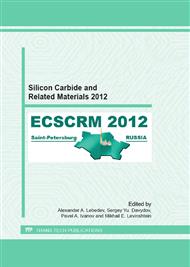p.217
p.221
p.225
p.229
p.235
p.239
p.243
p.247
p.251
Amorphous Silicon Carbide Film Formation at Room Temperature by Monomethylsilane Gas
Abstract:
The silicon carbide thin film formation process, completely performed at room temperature, was developed by argon plasma and a chemical vapor deposition using monomethylsilane gas. Silicon-carbon bonds were found to exist in the obtained film, the surface of which could remain specular after exposure to hydrogen chloride gas at 800 oC. The silicon dangling bonds formed at the silicon surface by the argon plasma are considered to react with the monomethylsilane molecules at room temperature to produce the amorphous silicon carbide film.
Info:
Periodical:
Pages:
235-238
Citation:
Online since:
January 2013
Authors:
Keywords:
Price:
Сopyright:
© 2013 Trans Tech Publications Ltd. All Rights Reserved
Share:
Citation:


